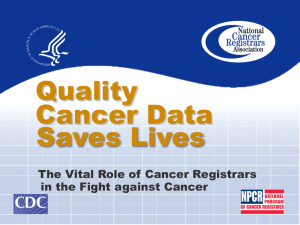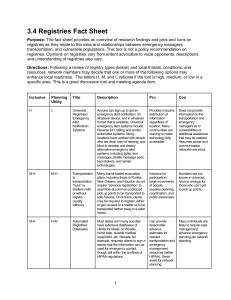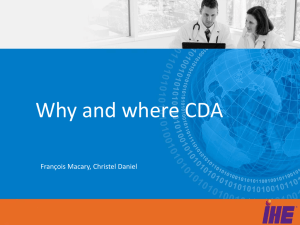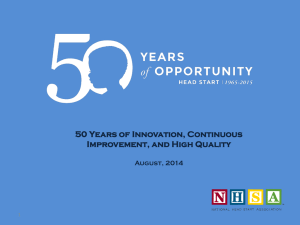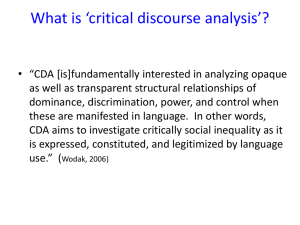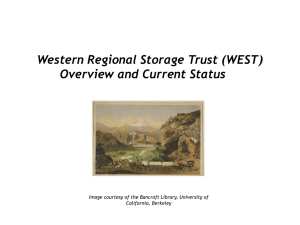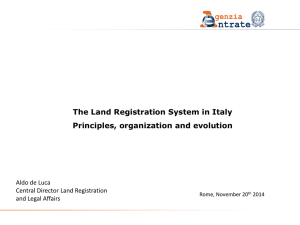Developing Informatic Tools in Support of Meaningful Use Electronic
advertisement
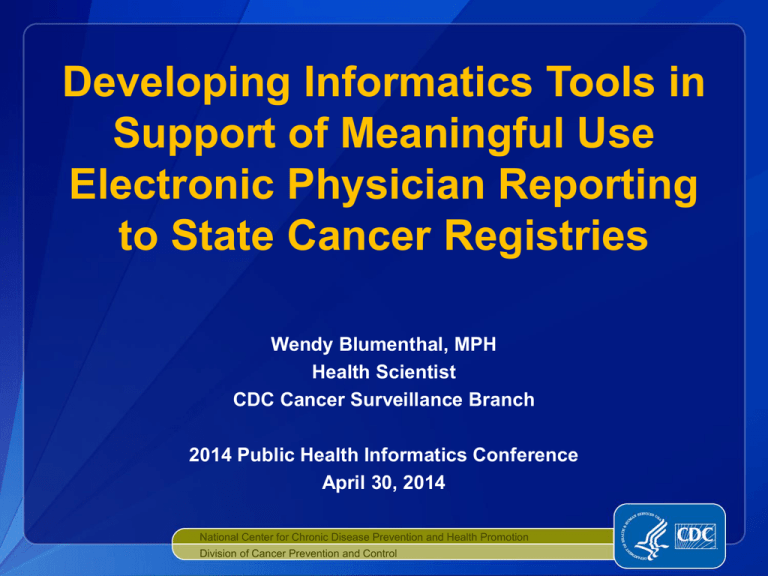
Developing Informatics Tools in Support of Meaningful Use Electronic Physician Reporting to State Cancer Registries Wendy Blumenthal, MPH Health Scientist CDC Cancer Surveillance Branch 2014 Public Health Informatics Conference April 30, 2014 National Center for Chronic Disease Prevention and Health Promotion Division of Cancer Prevention and Control Cancer Surveillance Overview 1992 Cancer Registry Amendment Act, Public Law 102-515, authorized CDC to establish National Program of Cancer Registries (NPCR) Worked with states to develop model legislation and regulations Cancer is a nationally reportable disease Collect data on all cancers diagnosed Highly standardized data collection system Coordinated across multiple agencies (CDC, National Cancer Institute, and American College of Surgeons Commission on Cancer ) through North American Association of Central Cancer Registries (NAACCR) Cancer Surveillance Regional, state and territorial Central Cancer Registries (CCRs) are data systems that collect, manage, and analyze data about cancer cases and cancer deaths Cancer surveillance is a complex system that captures longitudinal data from multiple data sources using a variety of methods In addition to recording the occurrence of each reportable cancer (or tumor), the reporters provide information to CCRs on the tumor diagnosis, stage and treatment as well as vital status Legislation requiring cancer reporting by healthcare providers to state cancer registries exists in all states with some variation in specific requirements NPCR – AERRO Scope Diagram Version 1.0 Revised 12-11-2008 Business Office Medical Records Disease Index Specialty Databases Pharmacies Oncology Clinics Radiation Oncology Hospitals with/without Registries Treatment Logs **Pathology Laboratory Diagnostic Imaging Admissions Outpatient Services Cancer Treatment Facilities *3 Freestanding Healthcare Practitioners *3 **Freestanding Pathology Laboratories *2 Health Insurance Plans *4 Bureau of Vital Statistics *5 Census Tract Database *5 State Health Departments *5 Central Cancer Registries Hospitals *1 IHS/Local Tribe Clinics *6 Prisons *10 Department of Motor Vehicles *9 National Cancer Programs/ Organizations SEER NAACCR ***CoC NPCR National Death Index *7 Voter Registration *9 State Cancer Registries *8 Freestanding Diagnostic Imaging Centers *8 Nursing Homes/ Hospices *8 NPCR–AERRO includes cancer data sources and the lines drawn to the Central Cancer Registries and the National Cancer Programs *Numbers rank the data sources on the quality of useful data available on a scale of 1 being the most useful and 10 being the least useful. **Pathology Laboratories–Freestanding and Hospital–send data to both the Hospital Registries and the Central Cancer Registries ***CoC receives data directly from hospitals. CMS and ONC Meaningful Use Final Rules for Cancer Reporting CMS Stage 2 Menu Objective for Eligible Professionals: Capability to identify and report cancer cases to a State cancer registry, except where prohibited, and in accordance with applicable law and practice ONC 2014 Edition EHR Certification Criteria: Optional---ambulatory setting only—transmission to cancer registries. EHR technology must be able to electronically create cancer case information for electronic transmission in accordance with the Implementation Guide for Ambulatory Healthcare Provider Reporting to Central Cancer Registries, HL7 Clinical Document Architecture (CDA) Implementation began January 2014 Physician Cancer Reporting Requirements (1) Tool needs to be available for use by EHR vendors and providers to test cancer CDA reports as well as by state cancer registries to analyze reports received Vendors, providers and registries need to perform robust structural and content validation of the physician reports in the HL7 Clinical Document Architecture (CDA) format required for MU Need to expand on the existing Schematron tool developed by NIST for ONC’s EHR certification process Physician Reporting Needs (2) HL7 CDA is brand new to cancer registries Need tool to “read” and parse CDA documents Data elements in the EHRs and therefore in the CDA cancer report often do not map exactly to cancer registry data elements Complex mapping rules and translations were developed by the cancer registry community Cancer registries receive reports from multiple sources for the same patient and tumor, and now will also receive multiple reports from the same provider for the same patient and tumor Consolidation functionality needed to merge multiple reports from the same provider for the same patient and tumor Physician Reporting Needs (3) Cancer registries have different needs for imports into central cancer registry database Some registries want to export all cancer abstracts immediately for import into central database Some want to wait until patient’s treatment is completed and export a single consolidated abstract for import into central database Some only want to export abstracts for cancer types that are likely un- or under-reported from hospitals, such as melanoma, prostate, bladder and leukemia. Highly configurable export features needed to address these diverse needs New Tool Development: eMaRC Plus Physician Reporting Module Electronic Mapping, Reporting, and Coding (eMaRC) Plus Imports and parses physician cancer HL7 Clinical Document Architecture (CDA) reports The physician reporting module was developed as an enhancement to eMaRC Plus. eMaRC Plus also includes a module to process HL7 version 2.5 electronic pathology reports. Maps and translates CDA data elements and values from concepts and vocabularies used by EHRs to the NAACCR Standards for Cancer Registries, Volume II, Data Standards and Data Dictionary used by state cancer registries Consolidates information from multiple cancer reports into a single cancer abstract, and enables abstracts to be exported in the NAACCR record layout Part of CDC’s Registry Plus suite of free-of-charge software eMaRC Plus—Mapping Rules Example eMaRC Plus—Mapping &Translation Example eMaRC Plus—Consolidation Example eMaRC Plus—Export Options New Tool Development: CDA Validation Plus Developed by CDC Cancer Surveillance Branch First release 11/22/2013; Version 2.0 released 4/15/2014 Assists EHR vendors and state cancer registries to test and validate HL7 CDA cancer reports from EPs for MU Stage 2 cancer reporting Performs structural and content validation based on the specifications in the Implementation Guide for Ambulatory Healthcare Provider Reporting to Central Cancer Registries, August 2012, Release 1.0 CDA Validation Plus Does NOT replace the testing and validation process that MUST be completed by EHR vendors with the Office of the National Coordinator - Authorized Testing and EHR Certification Bodies (ONC-ATCBs) to receive the required MU certifications It is to be used to augment the validation process and improve interoperability for cancer reporting Will be continually refined and enhanced based on functionality needs of end users See Training Manual for details on validation rules Page 9 describes types of validation rules Pages 10-12 provide examples Appendix B provides list of all rule types applied to data elements CDA Validation Plus Content validation includes checks for required elements and valid vocabulary values Generates user-friendly reports that can be printed and saved Reports can be saved to an extensive number of file formats Stand-alone desktop application Validation can be performed manually on a single document or a batch of documents Validation of a batch of documents can be automated through a command line interface CDA Validation Plus: Validation Rule Types Critical missing required fields Subset of required data elements that are considered critical to cancer registries Missing required fields Usually required by cancer registries but may not all be present in every CDA message and can be null in certain circumstances Invalid or unexpected null flavor Invalid Code System OID Invalid values Data element formatting, including: Social security number, telephone number, National Provider Identifier (NPI), and CPT and HCPCS codes Cancer Reportability CDA Validation Plus: Validation Window CDA Validation Plus: Report Summary CDA Validation Plus: Detailed Report CDA Validation Plus: Detailed Report Patient Centered Outcomes Research (PCOR) PCOR funding received from HHS to expand on Comparative Research Effectiveness project Extend follow-up of breast, colon, rectum cancer cases through 2014 Expand EHR reporting to cancer registries for comparative effectiveness research by addressing requirements to implement Meaningful Use cancer reporting, including Testing and enhancement of software tools Improved methodology for management and processing of electronic data on a real time basis Technical assistance, training, and guidance to cancer registries Resources If you would like to download either eMaRC Plus or CDA Validation Plus, please contact Lindsay Ryan (viu3@cdc.gov) for instructions For more information about MU Cancer Reporting, or to download the Implementation Guide and guidance documents please see the NPCR MU Web Site: http://www.cdc.gov/cancer/npcr/meaningful_use.htm For questions about MU reporting, please contact MeaningfulUse@cdc.gov Thank you! Wendy Blumenthal wblumenthal@cdc.gov 770-488-1131 For more information please contact Centers for Disease Control and Prevention 1600 Clifton Road NE, Atlanta, GA 30333 Telephone, 1-800-CDC-INFO (232-4636)/TTY: 1-888-232-6348 E-mail: cdcinfo@cdc.gov Web: www.cdc.gov The findings and conclusions in this report are those of the authors and do not necessarily represent the official position of the Centers for Disease Control and Prevention. National Center for Chronic Disease Prevention and Health Promotion Division of Cancer Prevention and Control
